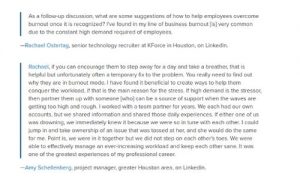HR leaders and their changing priorities in 2023

How To Create a Company Culture That Illustrates Your Core Values

At the end of 2022, it was more important than ever for HR departments to take note of successes and failures, but this year it’s all about scrutinizing the strategy every 30 days or every quarter to stay on track.
It’s no surprise that organizational design and change management are the top priorities for HR managers in 2023. This priority is because 46% of HR executives feel that they are unable to lead change when it is necessary.
To prepare for the future, human resource leaders must develop and incorporate the following skillsets into their portfolio, according to Gartner.
- Technological competence- As CHROs are a crucial part of strategic business decision-making in 2021, they need to be well aware of the latest technologies to suggest or quickly adapt to the changes.
- Employee experience- The year 2021 is more than just basic employee engagement. It is about capturing employee needs and providing them with a richer experience.
When investing in your HR initiative, you should consider the trends that will significantly influence the way you design and implement strategies, processes, and best practices. The question for HR managers is: Do the trends look similar to what we have seen in the past? What immediate action and long-term adjustments will be necessary?
Here are the 6 key trends in human resources that should be included in your HR agenda for 2021 and beyond.
Return to work policy
Human resources experts and managers navigate the new normal by presenting a “return to work plan” that includes what employees can expect in their physical workplace and what others can expect. For both employees and employers, you should outline the safety measures to implement and comply with these new guidelines.
Getting back to work means examining all risk factors and determining when ‘return to work’ is most beneficial for your employees and your organization. A good return and work policy helps your business thrive while protecting and supporting employees.
Bennett Coleman & Co. Ltd adopted and leveraged the new-age collaboration tools and chose to transition to a hybrid work environment. With a continuous focus on Employee Safety & Business Continuity, BCCL’s hybrid working entails an effective mix of 60-20-20, 20% from home exclusively, 20% working from the office, while the rest 60% follow a revolving roster approach.
Revamp your performance management strategy
Rather than spending your time figuring out what your teams did well during the pandemic. Weed out the process that ain’t working and introduce new ones.
Analysis of prevailing performance management practices and leading trends in the industry can also help to develop a clear vision of what an effective performance management system should include.This review will help you understand how effective your current performance management system is and where it needs to be improved. In addition, evaluate the impact of changes and consider what could be further improved or optimized in your performance management process, and be ready to make changes if needed. Make sure that your process is driven clear stating the objective of your performance management system and that you make progress in achieving these objectives whilst managing your organization’s performance.
PwC handles its performance management by way of frequent and informal feedback. Regular feedback compared to annual reviews helps individuals to quickly cover the gap, maximize their strength and drive L&D throughout the year.
Build out an HR crisis plan
If your company is one of the 51 percent of organizations that admit they do not have a crisis management plan, now is the time to sit down and start planning. The creation of a crisis management plan (CMP) prepares your employees for everything that is coming their way.
If there is anything other than an immediate threat to your business, plan for the unexpected by creating a rapid response plan. The crisis management team rehearses the crisis plan by developing simulated scenarios for exercises and organizing the response as soon as it becomes clear that a crisis is underway.
SAP India has approached their Crisis Management Team to review their employee’s office entry and exit requests to access the office space by following all local COVID-19 regulations like social distancing, wearing masks and adhere to personal hygiene they are all set to allow their employees to office who wish to come and work from the office and for the remaining, they have allowed work from anywhere until June 30, 2021.
Protect your people from burnout
Burnout is a growing workplace epidemic affecting all employees, but many companies may not be doing enough to minimize burnout. Nearly 70 percent of professionals believe that employers in their companies do not do a good job of preventing or alleviating burnouts. But the truth is that proper management practices, such as nurturing managers and educating employees about the importance of passion, can help keep employees from burning out. Passion may not prevent stress in the workplace: 87 percent of professionals surveyed said they have passion in their current workplace, but 64 percent said they are stressed, dispelling the myth that passionate employees are immune to the stress of burnout, according to anF American Psychological Association survey.
Encouraging employees to manage their emotions differently, rather than suppressing them, will help reduce burnout. Because burnouts and signs of redundancy are so closely linked, strategies to reduce burnouts can have the effect of increasing involvement. If you try to prevent burnout among your employees, you can help people get back to a better state of mind by helping to make it feel as if it already feels different.
Finally, it should be borne in mind that work – at – play can increase the risk of burnout among employees. High employee engagement is a big goal, but it can come at a high price if not managed carefully.

Above is an example of how HR community is finding ways to tackle employee burnout in this pandemic. Source: Linkedin
Focus on total rewards
A carefully designed Total Rewards program helps to increase employee retention and attracts new candidates to the company. As for overall compensation trends, we see that many employers are adjusting a total compensation program to match their talent value promise. A well-planned overall reward strategy gains a decisive advantage in terms of attractiveness, engagement, and talent retention.
Listening carefully to what your employees say helps you determine exactly where your organization needs to focus on in your Total Rewards strategy. You will find that there are several areas that Total Rewards should cover, and how to develop and implement them within your organization, including employee engagement, employee retention, employee satisfaction and overall reward program satisfaction. This includes a variety of aspects from remuneration, to fixed remuneration to allowances and other benefits such as holiday and sick pay.
Willis Towers Watson has explained how 2020 has reinforced the importance of a renewed commitment to diversity and inclusion and the focus filtering down to all different aspects of total rewards in their article – The future of Total Rewards.
Employee health and wellbeing programs
When it comes to workplace wellness programs, there are many offerings that focus on different ways to help employees become and stay active, healthy and happy. At its core, a wellness program for companies is an employer’s main project – a plan designed to improve the physical and mental health of employees.
Staff wellness programs can be one-off events or they can be an ongoing schedule of activities. Employers can use a variety of health and wellness programs, such as physical activity, fitness, exercise, yoga, meditation and yoga classes. Health information collected through a well-designed wellness program can also be used in an aggregated form to develop effective disease-fighting programs and treatments. This is a great way to expand your traditional employee wellbeing program and reach out to the population that is at higher risk of living with chronic diseases and is one of the most effective ways to manage employee health risks. The health information collected during a wellness program can not only be used to give employees meaningful feedback and advice on their health risk status but can also be used as a basis for developing an effective program to treat diseases.
Synechron‘s Managing Director and Country Head India, Hareesha Pattaje expressed their top priority for the year 2021 which is employee physical and mental wellbeing. To ensure their employee’s safety needs they are offering the best support to their employees where they already have hospital tie-ups, insurance and virtual counseling sessions across locations.
Undoubtedly, RPA, AI and VR are not the only top trends that will dominate in 2021, but the above mentioned points will remain among the top priorities in the years to come. The biggest shift that we will see in 2021 is the continued decline of one-size-fits-all HR solutions. Existing solutions will require newer versions to give organizations more control over their data.
The biggest challenge for the HR department in 2022 will be to devise a way to truly transform the digital business. Working on a smart HR tech stack is the safest way to prepare your team for the future, prioritize your efforts, and achieve your human resources goals for 2022.
Business values can heavily influence your brand identity and how outsiders view your company. It is therefore imperative that a company has very firm values and the same is embodied in all aspects of their business.
Let’s begin with a quick recap of what we know about values. Values are individual belief systems that motivate people to act one way or another. They serve as a guide for human behaviour. Generally, people are predisposed to adopt the values that they are raised with. Ethical decision-making often involves weighing values against each other and choosing which values to elevate. Conflicts can result when people have different values, leading to a clash of preferences and priorities. Some values have intrinsic worth, such as love, truth, and freedom. Other values, such as ambition, responsibility, and courage, describe traits or behaviours that are instrumental as a means to an end.
As an individual, values essentially serve as a guide to growth and development. They help us create the future we want to experience. Much like individuals, organizations also need values directed towards a specific purpose, be it growth, development or business success. These cannot be attained in the absence of a strong value-based organizational culture that embodies it’s core values.
Strong value-based work culture is a precursor to business success
Organisations are involved in making hundreds of decisions every day. The decisions they make are a reflection of their values and beliefs, and they are always directed towards a specific purpose. That purpose is the satisfaction of organizational needs. Organizational values reflect how your organization operates in the business world. Successful organizations develop and follow their organizational values.
For instance – Walt Disney; it is not just among the most recognizable brands in the world, they also are the kindest community on the planet. A brand which is almost synonymous with magic, Disney extends the magical experience even to its employees as a part of the company’s culture. (quoted from surveysparrow blog-7 Fabulous Organizational Culture Examples You Can Learn From!)
What Sets Them Apart: Unparalleled heritage, pride and culture, wonderful community, amazing growth opportunity, and a creative atmosphere sets them apart, says a Disney employee. Disney only hires people who align with what their brand stands for. The organizational benefits of being a Disney employee include access to Mickey’s Retreat (an exclusive area accessible only to Cast Members and their families), generous discounts on Disney parks, hotels and merchandise, incentive schemes and private healthcare. Takeaway: Disney strives to make every place the happiest place to work and is compassionate towards each other. People can tell when their company cares for them and in Disney’s case, employees care back!
It was Peter Drucker who famously said that Culture eats strategy for breakfast’. No kidding. A work culture can absolutely be the deal-breaker or decisive factor when it comes to defining a company’s success. Great company culture just doesn’t happen on its own. It’s more than mere fun and games. It’s beyond the inspirational quotes and artwork chalked onto the pillar, glowing customer recommendations lining the walls, and bean bags littered across the floor. All that is nice and makes life more pleasant, but it does not change the core of who you are as a company. Great organizational work culture is more than paychecks, fun, and perks.
HOW TO CREATE A CULTURE AROUND YOUR CORE VALUES
Company culture is a difficult concept to put into words but it is synonymous with your business environment. Good company culture takes years to develop, but there are some steps that you can take today to get this plan in motion:
1. Pin Down your core values:
Alright! First things first, you need strong core values to set up the base for your company’s culture. Your core values need to be established and ingrained in your company if you are to have a successful company culture. If your core values are not defined, there will be no culture. In the absence of a defined culture, organizations usually form their own culture, which is not based on values and best practices. This can be detrimental to the business image in the long run.
“When I began my startup, I did not have any set values. Personally yes, I had a set of values I operated upon, but however, it didn’t seem necessary to establish company values at such an early stage. Eventually, my business grew and so did my team. I now started seeing the challenge of encouraging the team to make decisions, based on the values I personally embody as guidelines. This became an even bigger challenge with employees who operated remotely. I finally realized the importance of having set company values. However, I kept putting it off since I didn’t know where to begin. But once I sat to actually pen down Moneyjar’s values, it didn’t take more than 15 mins” – Rohan Agarwal (Co-Founder Moneyjar)
To create your business values, think about your personal values, business objectives and align them to match it with your workforce potential. See which value-based decisions have kept you on your growth track and which have helped your employees perform better. Keep the ones that serve your indicators of success and match the goals you have chalked out for your business. A quick search on google with also reveals a great set of values you can imbibe. Go ahead if that suits you, however, remember your values must be tailor-made and should not be more than 3-4 in number.
2. Identify behaviours that demonstrate these values:
Once you have nailed down your core values, you must bring it into action. Sometimes organizations may be operating under unspoken core values, communicate them formally to the workforce and practise it daily. Daily reinforcement is the best way to form a habit. Identify touchpoints to remind them of these values. Everyday things like setting business hours, determining employee benefits and internal communication with employees, reflects your culture. So, ingrain your values in these decisions from the start.
Establish Key Behavioural Indicators that demonstrate your core values. For instance, If you are a customer service based company which has adopted “Going the extra mile to achieve customer satisfaction” as a core value, your employees must embody the same value and must be willing to go that extra mile whenever the opportune moment surfaces.
For example, you have probably heard of the Ritz-Carlton, a hotel chain known for their great customer service. On one particular visit, a mother together with her two children had spent a few days there on vacation, and when they got back home, her son discovered that his beloved stuffed giraffe, Joshie, had gone missing. The boy was devastated, so his parents decided to tell him that “Joshie is just taking an extra-long vacation at the resort.” This conversation was overheard an attendant at the front desk and he took it upon himself to ensure they leave happy. That very same night, the Ritz-Carlton called to tell them that they found Joshie. The relieved parents asked if the staff would mind taking a picture of the giraffe at the hotel to authenticate a fabricated “long vacation” story. After a couple of days, the parents received a package with Joshie and a bunch of pictures that proved Joshie’s prolonged holiday. (quoted from Brand24 blog) (once again keep the formatting same across sections and while quoting another blog also add the link)
Organizational culture depends largely upon the behaviour of its employees. So you must ensure that employees behave in a fashion that resonates your core values. Not just existing employees, but even new hires should be done keeping in mind the core values, so it becomes easier to integrate them into the organizational setup. Many companies have started carrying out an interview with a culture fitment angle to ensure the right candidate is hired.
3. Induct all employees into the values:
When bringing on new employees or when you update your company values, don’t skip onboarding and training. These are great opportunities for you to set the tone. Talking about your core values periodically can also help you to implement them in your corporate culture. You can send out monthly newsletters that showcase employees who are successful in following your business’s values. Also, you can bring up core values in goals meetings and determine whether you are reaching goals., You can discuss core values during employee performance reviews. Don’t let them get cosy in the corner of your small business. Frame them and hang them on the wall for employees and customers to see. Post them on your website, on your social media pages, and on any other digital front, you can. Many companies proudly display their core values on video walls or television screens in the frontal view of the office, to ensure both employees and customers understand them. Customers/ employees can get an idea of what the organization’s culture will be like basis the values displayed and take decisions accordingly.
4. Reward employees when they act as per the desired behaviour:
So the values are set, the employees are inducted and business is great! It’s no wonder these thoroughly thought out core values worked like a charm. If you’re thinking you’ve created your business Utopia, think again! Is it enough to just establish a successful culture? Employee Recognition plays an important role when it comes to building a company culture. Once the values are set and let’s say employees strive to adhere to them, then as an organization, it becomes your responsibility to recognize these efforts and reward these behaviours. These values help gauge the performance of employees and recognize their efforts in order to keep them engaged. Acknowledging and rewarding value-based behaviour encourages the employee to perpetuate this behaviour throughout his/her tenure with the organization. When these behaviours are rewarded it creates an emotional connection between the employee and company and they achieve a state of synergy and eventually attain employee engagement.
In today’s day and time, employee recognition can be also done digitally which also allows business owners to track individual performance and measure it against core values and reward employees. Such unique platforms provide superior employee engagement, not just among superiors and subordinates but also enhance peer-to-peer engagement. For instance, Let’s Buzzz platform allows peer-to-peer employee appreciation model, where employees across departments and ranks appreciate and recognize fellow employees for demonstrating certain behaviours by buzzing about it and thereby creating a chain reaction of acknowledgement and occasionally nudging whenever a core value is displayed, which in turn leads to driving a value-based culture. Core values are beliefs your business must follow in all aspects of its operations, be it marketing, human resources, administration and finance. They guide decision-making and define what your business stands for. But, if you and your employees fail to uphold your core values, you could face bemused or disappointed customers.
